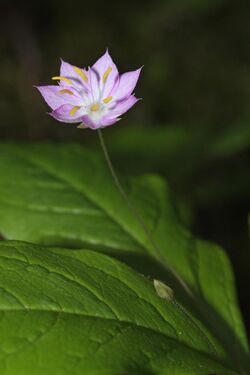Biology:Lysimachia latifolia
| Lysimachia latifolia | |
|---|---|

| |
| At Squak Mountain State Park | |
| Scientific classification | |
| Kingdom: | Plantae |
| Clade: | Tracheophytes |
| Clade: | Angiosperms |
| Clade: | Eudicots |
| Clade: | Asterids |
| Order: | Ericales |
| Family: | Primulaceae |
| Genus: | Lysimachia |
| Species: | L. latifolia
|
| Binomial name | |
| Lysimachia latifolia (Hook.) Cholewa
| |
| Synonyms[1] | |
| |
Lysimachia latifolia, sometimes called Trientalis latifolia, is a species of flowering plant in the family Primulaceae.[1][2][3][4] It is known as starflower,[3][4][5] chickweed-wintergreen,[5] or Pacific starflower.[6]
Description
It is a low-growing, creeping perennial[5][7] reaching (5 to 30 cm (2.0 to 11.8 in)).[8] The roots are tuberous,[5][7] creeping rhizomes.[7] The stems are erect,[7] 10–20 cm (4–8 in) high.[5] It has 5 to 7 whorled, lanceolate, entire leaves distributed levelly in a single group.[7]
The flowers are white[5][7] or pink[5] flowers are borne in April[5] or May.[5][7] Calyx (the collective term for sepals) is 5- to 9-parted and persistent. Corolla (the collective term for petals) is also 5- to 9-parted, rotate,[5][7] with a very short tube[7] and elliptic-lanceolate segments. Stamens occur in the same number as the corolla lobes (5–9)[5][7] and are positioned opposite them.[5] 1-3 peduncles, 1-flowered, filiform, and ebracteate.[7] The ovary is one-celled. The style (gynoecium) is filiform.[5]
Habitat
Occurs on moist, shaded[3][7] slopes in deep,[3] light[7] soil rich in organic matter,[3][7] particularly leaf mould.[7]
Distribution
- Canada : Occurs in British Columbia, Alberta, and Yukon.[9]
- United States of America : Occurs throughout Washington (state) , Idaho, Oregon,[9] and northern[5] California .[9]
Etymology
The former genus name Trientalis is derived from the Latin triens ('a third'), and is an allusion to the height of the plant, which is one third of a foot, or 4 in (10 cm) high.[5][10] Latifolia is derived from the Latin words latus ('broad or wide') and folia ('leaves') and means approximately 'broad-leaved'.[10]
The alternative name "Indian potato" refers to a small subterranean swelling at the stem's base, which is not listed as being edible by modern sources.[11]
References
- ↑ 1.0 1.1 "Lysimachia latifolia (Hook.) Cholewa". Royal Botanical Gardens Kew. https://powo.science.kew.org/taxon/urn:lsid:ipni.org:names:77138093-1.
- ↑ The Plant List http://www.theplantlist.org/tpl1.1/record/tro-26400203
- ↑ 3.0 3.1 3.2 3.3 3.4 Howell, John Thomas. "Marin Flora: Manual of the Flowering Plants and Ferns of Marin County, California", University of California, Ltd. Copyright 1949, 1970, 1985. ISBN:0520056213, pp 217
- ↑ 4.0 4.1 Emery, Dara E. "Seed Propagation of Native California Plants", 6th edition (printed 2011). Copyright 1988 Santa Barbara Botanic Garden. ISBN:0916436039
- ↑ 5.00 5.01 5.02 5.03 5.04 5.05 5.06 5.07 5.08 5.09 5.10 5.11 5.12 5.13 5.14 Parsons, Mary Elizabeth "The Wild Flowers of California", illustrated by Margaret Warriner Buck. Published by Cunningham, Curtiss & Welch, San Francisco 1912. Copyright William Doxey 1897, copyright Mary Elizabeth Parsons 1902, 1906. (no ISBN for this edition)
- ↑ "When to expect the blooms?". National Park Service, U.S. Department of the Interior. November 24, 2017. https://www.nps.gov/redw/learn/nature/whenbloom.htm.
- ↑ 7.00 7.01 7.02 7.03 7.04 7.05 7.06 7.07 7.08 7.09 7.10 7.11 7.12 7.13 7.14 Chittenden, Fred J., Synge, Patrick M., editors. 1977. "The Royal Horticultural Society Dictionary of Gardening", edn. 2, Oxford University Press. ISBN:0198691068. Volume 4, pp. 2145-2146
- ↑ "Lysimachia latifolia". https://ucjeps.berkeley.edu/eflora/eflora_display.php?tid=99406.
- ↑ 9.0 9.1 9.2 USDA Plants database Trientalis latifolia
- ↑ 10.0 10.1 Gledhill, David (2008). "The Names of Plants". Cambridge University Press. ISBN:9780521866453 (hardback), ISBN:9780521685535 (paperback). pp 231, 387
- ↑ Whitney, Stephen (1985). Western Forests (The Audubon Society Nature Guides). New York: Knopf. p. 586. ISBN 0-394-73127-1. https://archive.org/details/westernforests00whit/page/586.
External links
Wikidata ☰ {{{from}}} entry
 |

